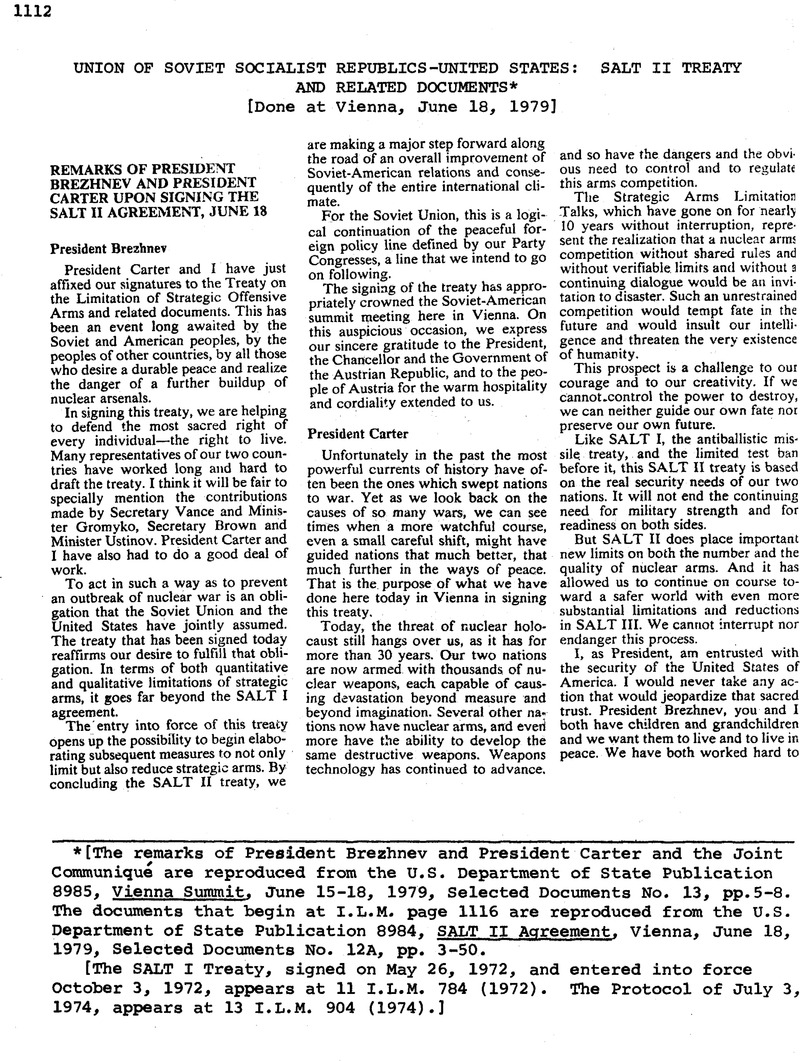No CrossRef data available.
Published online by Cambridge University Press: 20 March 2017

[The remarks of President Brezhnev and President Carter and the Joint Communique are reproduced from the U.S. Department of State Publication 8985, Vienna Summit, June 15-18, 1979, Selected Documents No. 13, pp.5-8.The documents that begin at I.L.M. page 1116 are reproduced from the U.S. Department of State Publication 8984, SALT II Agreement. Vienna, June 18, 1979, Selected Documents No. 12A, pp. 3-50.
[The SALT I Treaty, signed on May 26, 1972, and entered into force October 3, 1972, appears at 11 I.L.M. 784 (1972). The Protocol of July 3, 1974, appears at 13 I.L.M. 904 (1974).]
1 Treaty on the Non-Proliferation of Nuclear Weapons, signed at London, Moscow and Washington, July 1, 1968, 21 UST. 483, TIAS
6839 The United States and the Soviet Union are both Parties to this Treaty.
2 Interim Agreement Between the United States of America and the Union of Soviet Socialist Republics on Certain Measures With
Respect to the Limitation of Strategic Offensive Arms, signed at Moscow, May 26, 1972,23 UST 3462, TIAS 7504.
3 While the Protocol is in force, the Parties are prohibited from deploying mobile ICBM launchers or flight-testing ICBMs from such launchers.
4 Elsewhere in this document the term “longrange”, as applied to cruise missiles, will be used to refer to such missiles which are capable of a range in excess of 600 kilometers.
5 The definition of heavy ICBMs is contained in paragraph 7 of Article II, discussed above.
6 The figure of seven reentry vehicles for the Trident C-4 is based on the maximum number of reentry vehicles actually released during flighttests of the missile as of May 1, 1979. If simulated releases of reentry vehicles had been counted as flight-tests of reentry vehicles, as is the case for simulations occuring after May 1, 1979, the figure for the C-4 would have been eight, which is the largest number of reentry vehicles for which the missile is designed and with which it will be deployed.
7 Treaty Between the United States of America and the Union of Soviet Socialist Republics on the Limitation of Anti-Ballistic Missile Systems, signed at Moscow, May 26, 1972, 23 UST 3435, TIAS 7503.
8 Note that the Treaty makes a distinction between the term “airplane” (a vehicle which sustains flight by use of fixed or variable-geometry wings) and the term “aircraft” (which also includes vehicles such as helicopters and dirigibles)
9 The Treaty on the Prohibition of the Emplacement of Nuclear Weapons and Other Weapons of Mass Destruction on the Seabed and the Ocean Floor and in the Subsoil Thereof, signed at Washington, London and Moscow February 11, 1971, 23 UST 701, TIAS 7337. The United States and Soviet Union are both Parties to this Treaty.
10 Treaty on Principles Governing the Activities of States in the Exploration and Use of Outer Space, Including the Moon and Other Celestial Bodies, signed at Washington, London and Moscow January 27, 1967, 18 UST 2410, TIAS 6347. The United States and Soviet Union are both Parties to this Treaty.
11 Agreement Between the United States of America and the Union of Soviet Socialist Republics on the Prevention of Incidents On and Over the High Seas, signed at Moscow, May 25, 1972, 23 UST 1168, TIAS 7379.
12 Agreement on Measures to Reduce the Risk of Outbreak of Nuclear War Between the United States and the Soviet Union, signed at Washington September 30, 1971, 11 UST 1590, TIAS 7186.
13 The Interim Agreement also stated that the Parties would use the Standing Consultative Commission to promote the objectives and implementation of the provisions of that agreement.
14 Memorandum of Understanding between the United States and the Soviet Union Regarding the Establishment of a Standing Consultative Commission, signed at Geneva December 21, 1972, 24 UST 238, TIAS 7545.
15 Article 102 of the U.N. Charter provides that every treaty and international agreement entered into by any U.N. Member shall as soon as possible be registered with the Secretariat and published by it.